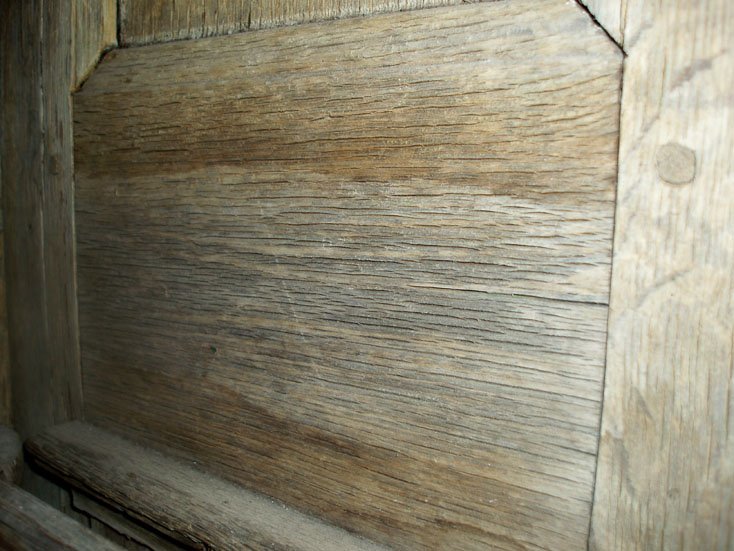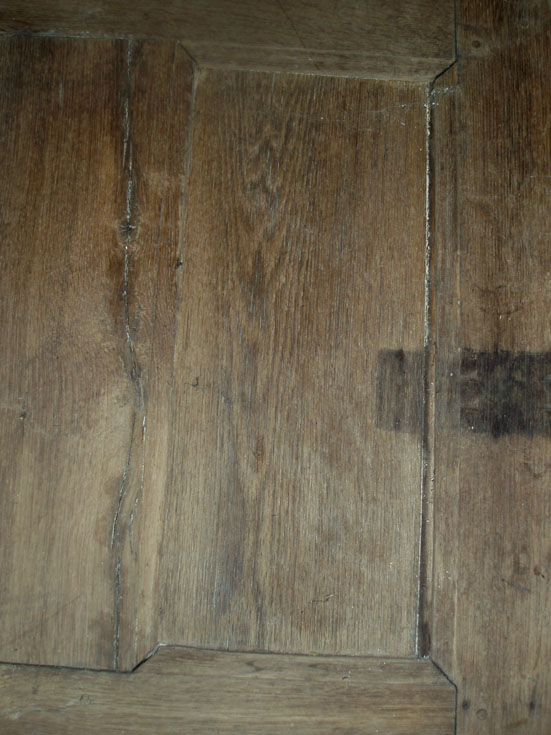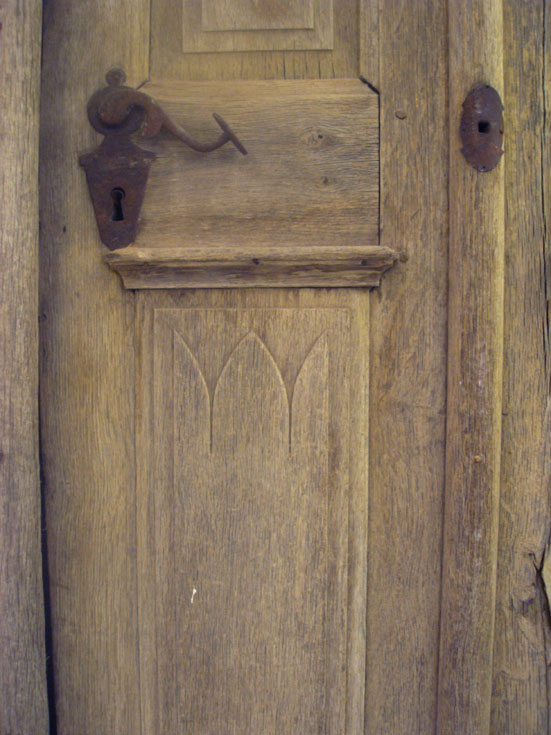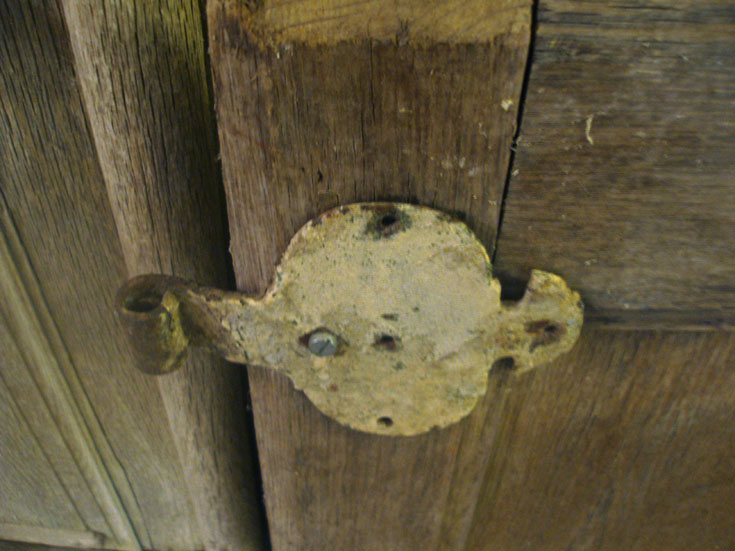| Author | Message | ||
| haddimudd
Advanced Member Username: haddimudd Post Number: 203 Registered: 6-2002 |
A friend of mine recently disclosed a medieval door which he has lying around in his vault after someone gave it to him a couple of years ago. He claims it to be over 800 years old. Now, this is not my door and probably never will be, but here we are in the dreaming for now section: Would it be useful in any way to use for a bass or guitar? I looked at the wood and it is very very dry, the grains are very open and need to be filled for sure. I don't even know what kind of wood this is but it smells fantastically old, not rotten at all. Since it is a door it is not one thick chunk but is made from various not too thick planks. I would be curious if one could take enough wood from this door to use on a bass and especially for what parts on the bass? Surely for the top and back laminate, but would I also want to use any of the wood in the neck or the body center? Of course, without knowing what kind of wood this is there is probably not much useful to say in this matter. Would it be desirable at all to use such old wood or wouldn't it make much difference to let's say twenty or fifty years old wood? Curious. Hartmut | ||
| cozmik_cowboy
Intermediate Member Username: cozmik_cowboy Post Number: 105 Registered: 10-2006 |
I imagine it would depend on the species of wood - there's a luthier named Laurie Williams in New Zealand who makes accoustic guitars from a wood called "ancient kauri" - these trees were buried in bogs, and are now being dug out and used. The wood is in the range of 30,000 years old! This guy claims they sound great - they're sure beautiful. I think this would look really good on a Balance K - unfortunately, NZ law only allows it to be exported as a finished product. Some one over there want to check them out & report back on the tone? Peter | ||
| tbrannon
Advanced Member Username: tbrannon Post Number: 317 Registered: 11-2004 |
NZ faction chiming in.... I haven't heard nor played any of Laurie William's stuff, but there is a local guy in Te Kowhata who makes basses out of Kauri, Rimu and other native woods. Additionally, check out Langcaster basses and guitars. Probably the worst looking (in terms of the cheese factor) website ever, but I've heard the basses and guitars and have played one of the basses (unplugged). Wonderfully made and absolutely stunning (minus the hideous headstock design). http://langcaster.com/ | ||
| dfung60
Advanced Member Username: dfung60 Post Number: 229 Registered: 5-2002 |
You may have heard of this bass before (second instrument down on this page, there's no direct link). The wood in in this one is almost 32,000 years old. It's not mentioned in the description, but the mammoth neck inlay is actual mammoth ivory! <p> Of course, another famous instrument using old wood is Brian May's main instrument in Queen, the neck of which was made of mantle wood from an old castle. <p> As for your friend's door, the good part of such an old piece of wood is that it should be totally cured and stable. Whether it's appropriate for use in an instrument is sort of hit or miss, but that would be the case with any piece of wood! David Fung | ||
| jazzyvee
Senior Member Username: jazzyvee Post Number: 760 Registered: 6-2002 |
tbrannon, I agree, the guitars look stunning. Hate the headstock though... looks dog rough. Jazzyvee | ||
| haddimudd
Advanced Member Username: haddimudd Post Number: 204 Registered: 6-2002 |
Thanks guys! Yes, I had heard about the ancient wood instruments and it surely is special to have wood that was buried and preserved for a couple of thousand years. It seems like several instrument makers have access to that kind of wood these days (although they all pretend to be the very exclusive ones) and obviously you have to pay big time for it. The medieval wood was not buried and thus not preserved since the time it exists so it may be a different pair of shoes after all. David, what you said is what I guessed, the cured state of the wood. I was curious what time span is generally recommended for curing of instrument wood? I remember Mica once mentioning a pile of Rosewood they use exclusively on Anniversary instruments just because they had it curing for the last twenty years and now use it until it is gone. Actually, that was ten years ago, so that wood may already be 30 years or older by now. Can wood turn unusable by just being shelved in the wrong way for too long? Can it ever become too dry or is as dry as can be a good thing for instrument wood? David, the legendary Brian May guitar was the first I heard of in this matter when I was a kid and it had always impressed me. For a long time I was under the impression that his distinct sound is due to this old wood in his instrument. Of course, today I know better that most of the distinct sound comes from his fingers, like most great musicians. Hartmut | ||
| lbpesq
Senior Member Username: lbpesq Post Number: 2113 Registered: 7-2004 |
As I recall, Steve Cripe made the guitar he gave to Jerry Garcia out of an old opium den bed. Bill, tgo | ||
| jahnahisti
Junior Username: jahnahisti Post Number: 44 Registered: 9-2005 |
I think the opium bed is a style of bed rather than the location of the bed. I know a guy who has the 2nd resurrection lightning bolt made. It's made out of the same hunk of wood as jerry's Lightning bolt was.  (Message edited by jahnahisti on February 22, 2007) | ||
| dfung60
Advanced Member Username: dfung60 Post Number: 230 Registered: 5-2002 |
Hartmut - With regard to curing wood, I don't think there's any specific time before the wood is considered cured. What's happening is that the internal moisture content of the wood is higher when the tree is alive, and drops after it is milled. The wood is "cured" when the internal moisture reaches some manner of equilibrium with the environment. At that point, it's more stable dimensionally and less likely to be subject to shrinking or warping. In addition to being structurally preferrable, it should be tonally better at this point as well. Even though the moisture content is stable, there may still be chemical changes happening internally. When you are producing commercial lumber to build a house, the wood spends time drying in a kiln, but I think think exotic woods are normally air dried. In a kiln, I believe the drying time for exotic woods is sort of on the order of a couple of months; to air dry it will be years. I believe that this will matter a lot more in an acoustic instrument (violin or acoustic guitar) than an electric instrument. I'm not sure if it's the same rosewood or not, but the burl rosewood that's used on the 25th Anniversary basses is extremely amazing and would be impossible to get in any significant amounts anymore because of the CITES treaty that limits the traffic of non-renewable woods. I have a bass built with this wood (the Series II on Alembic's website page is mine), which I got because I had seen a NAMM bass made of the same stuff (it went to Germany, then was sold to Jason Newstead, I think). When the 25th Anniversary bass was designed, I believe they held the rest of that wood for that limited run of instruments. Alembic took my bass down to a couple of NAMM shows for the booth display, and Mica mentioned that Jimmy Johnson tried it out, but his wife wasn't too fond of the rainforests that had to be levelled to yield the burl rosewood and ebony. I think wood can easily be damaged in storage. Too humid and it will lead to breakdown of the wood structure. Too dry and this can lead to structural problems, and might affect the instrument's tone as well. Of course, temperature would be a factor as well. But if the wood was finished in the past and kept in relatively stable and mild conditions, it's probably OK. I'm interested in the technical aspects of wood, but have precious little hands-on experience, so please take these comments with a grain of salt. David Fung | ||
| haddimudd
Advanced Member Username: haddimudd Post Number: 205 Registered: 6-2002 |
David, thanks for your explanations. Honestly, I do admire Jimmy Johnson's wife's attitude in respect of the rain forest issue. In regards to the Anniversary Rosewood, I remember Mica telling me that after the first Anniversary was finished, Ron decided that this was the best sounding bass they had ever produced. However, when the next Rosewood Anniversary was finished, Ron decided that this new bass was the best sounding one. And so on. I love this story. There really must be something about this special pile of Rosewood. I always found that I wanted a bass made out of this Rosewood too, especially since I also like its looks better than Coco bolo. Yet I am rather into Series instruments than Anniversaries, so there was no way Mica would give in on this. I hope she doesn't mind me giving away these little anecdotes. The medieval wood I am talking about is surely dry but it doesn't look too bad in terms of structure. Maybe I can try and shoot some close up photos. Perhaps this way somebody can also recognize the type of wood. Hartmut | ||
| jags
Member Username: jags Post Number: 76 Registered: 12-2006 |
the best thing to do, i would say, is if you can, get a couple of small splinters from it, mail them to alembic. they will put them under a microscope and maybe they can identify it for you. give them a pic or two,or three also wont hurt. make a little care package to mica | ||
| haddimudd
Advanced Member Username: haddimudd Post Number: 206 Registered: 6-2002 |
Here are some pictures I took of the wood in question: The complete door is about 185 cm high and is composed of three pieces: The slim piece on the left goes all the lengths from top to bottom. The right part is split for a lower and upper piece:  This is what the grain looks like on the front up close:  On the rear the wood looks less dry and the grain is not so open as on the front:  A closer look to the door latch:  The rather corroded hinge on the rear side (the greenish color is actually white in the real world):  I could take some splinters off but I realized that the areas where you can easily pull out some splinters are the areas of more rotten quality than the better parts. So the splinters may not be sufficiently representative for the usable areas of the wood. Can anybody identify the type of wood? Hartmut (Message edited by haddimudd on February 24, 2007) | ||
| cozmik_cowboy
Intermediate Member Username: cozmik_cowboy Post Number: 106 Registered: 10-2006 |
Judging from the pictures, especially the 3rd one, I'd guess oak. Like most doors, it seems to be constructed of a number of pieces - rails, stiles, panels, etc. Are any of them actually big enough to use for an instrument? Also, the grain looks like it's really dry, and has has a fair amount of water damage. If it were my door, I'd purasue the possibility of using it thus, but would not get my hopes up. Peter | ||
| haddimudd
Advanced Member Username: haddimudd Post Number: 207 Registered: 6-2002 |
Thanks Peter. Good point, many doors are/were made from oak. Never seen or heard of any guitar made out of oak though. I wonder why. The large area in the third picture is about 43x18 cm. Not sure if it continues under the parts next to it. I guess it equals the scale of the ornamental center areas on the front of the door. That is probably as big as it gets. There may be some long parts on the left door suitable for neck construction. The thickest pieces (borders) are about 3-4cm thick. All others would be thinner. I am not sure about water damages. The pictures may be misleading as I adjusted the contrast and colors quite a bit to better see the structure of the grains. On the original door the darker areas are less contrasted than the pictures. Also the last picture looks more rotten than the real door due to the picture being adjusted from a yellow lighting tint to more resemble the natural color. By that green has been introduced in the picture where there is no green really. Anyway, it probably makes most sense to preserve this door as a door and not chop it to bits. I loved the idea of a medieval bass though. I would have come up with some nice medieval inlays - well, if it ever was my door, which it is not after all. I may nevertheless take a splinter to somebody who can analyze the real age, just for curiosity's sake. Thanks for your thoughts everybody! Hartmut (Message edited by haddimudd on February 24, 2007) | ||
| chuck
Member Username: chuck Post Number: 76 Registered: 3-2005 |
Looks like oak to me. Should be ok for making a top lam.Wood of this age is very stable.Wet sanding with clear filler using the woods own sawdust would make for a very nice top. Chuck | ||
| lbpesq
Senior Member Username: lbpesq Post Number: 2117 Registered: 7-2004 |
Medieval bass? Has to be a 3x omega "battleaxe", I would think. Bill, tgo | ||
| keith_h
Senior Member Username: keith_h Post Number: 701 Registered: 2-2005 |
Looks like oak to me. Oak doesn't really have any resonance to it as far as I know. Good for doors and floors but not very good for an instrument. Keith | ||
| cozmik_cowboy
Intermediate Member Username: cozmik_cowboy Post Number: 108 Registered: 10-2006 |
Harmut, my comment on water damage wasn't based on the color, but rather on the open condition of the grain - when oak gets wet, the grain spreads. As to use of oak in guitars, I've never heard of it for a neck - I can't give you a reason (Mica?), but that just doesn't feel like it would work. I've seen at least 1 or 2 Alembics on here with oak cores - would an owner like to give us a report on that? And a few years back Washburn brought out a limited edition of accoustic guitars made from the oak pews they took out when they remodeled the Ryman Auditorium - haven't come across one in person, so I don't know how successful they are as instruments, but I figure they've got to have some serious mojo. Peter |